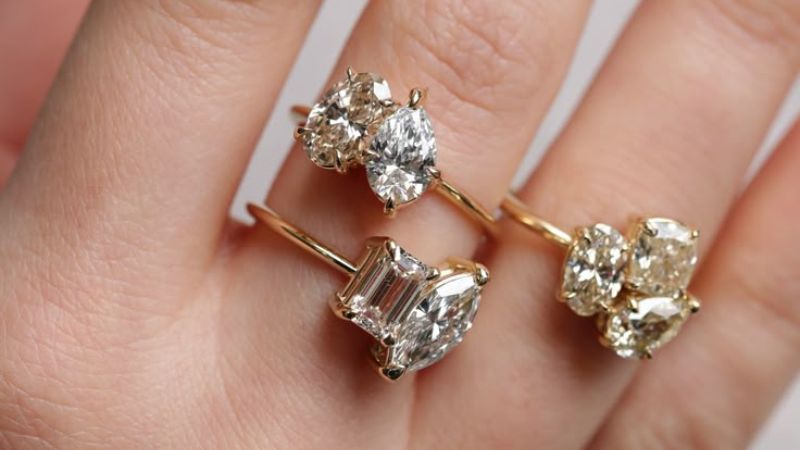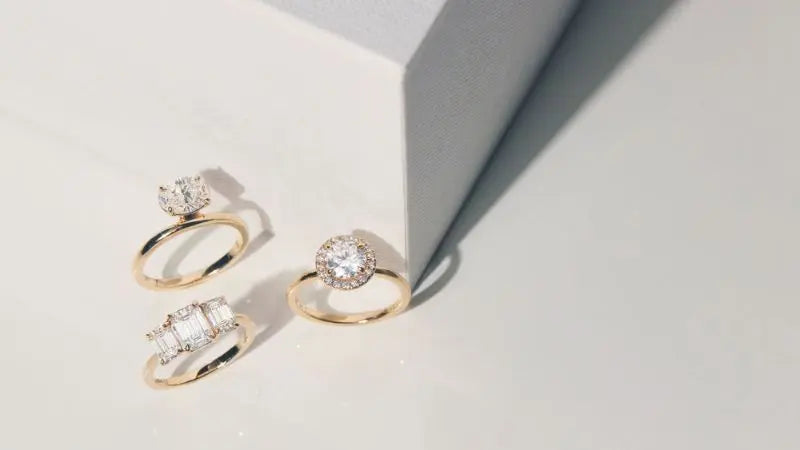Up To $2,500 OFF at checkout - Ends Dec 12
Free 30-day Returns | Lifetime Warranty
To help you find the perfect fit, we are breaking down everything you need to know about different engagement ring settings.
1. Introduction
Have you ever seen two rings with similar diamonds but felt drawn to one more? That’s the magic of the setting. It defines the ring’s style and enhances its beauty.
The right setting reflects your personality and brings lasting joy. Here’s what you need to know about engagement ring settings.
2. What is an Engagement Ring Setting?
A ring setting refers to how the diamond is mounted on the band. It affects style, security, and sparkle. Some settings maximize brilliance, while others prioritize durability. The best choice depends on your taste and lifestyle.

The hidden halo round cut diamond Serena and the oval cut Jasmine diamond ring
Settings highlight different aspects of a diamond—its brilliance, color, or shape. Choosing the right one ensures your ring is both stunning and comfortable to wear.
3. Popular Engagement Ring Settings
Picking a setting can feel overwhelming. Focus on first impressions, lifestyle fit, and personal joy. You can’t go wrong.

Types of engagement ring settings
3.1. Prong Setting
The prong setting is classic and widely used. Metal claws hold the diamond securely while allowing maximum light exposure. A four-prong setting enhances brilliance, while a six-prong adds security. Though elegant, prongs can snag and require maintenance.

The Textured Twig cushion lab diamond ring
3.2. Solitaire Setting
A solitaire ring features a single center stone with no extra accents. The name comes from the Latin “solitarius,” meaning alone.

The solitaire Sarah oval lab diamond ring
Solitaires can include design details like a split shank or textured band. Simple and timeless, this is the most popular setting.
3.3. Bezel Setting
A bezel setting wraps a metal rim around the diamond for protection. This modern, sleek design prevents chipping and holds the stone firmly.

The pave Charlotte pear lab diamond ring
A full bezel encircles the diamond entirely, while a partial bezel leaves some edges exposed for extra sparkle. While secure, it slightly reduces brilliance.
3.4. Halo Setting
The halo setting surrounds the center diamond with smaller stones, making it appear larger and more brilliant.

The Michelle round lab diamond ring
A double halo amplifies sparkle, while a hidden halo subtly enhances the stone from below. Tiny diamonds require regular maintenance to stay secure.
3.5. Pavé Setting
A pavé setting features small diamonds set closely along the band, creating continuous sparkle. This style adds elegance and enhances brilliance.

The pave Sarah marquise lab diamond ring
Variations include micro-pavé for a delicate look and French pavé for extra light reflection. While stunning, tiny stones may loosen over time.
3.6. Channel Setting
The channel engagement ring settings secure small diamonds between two metal strips on the shank of the ring. This design is durable and resistant to snagging, making it ideal for everyday wear.

Channel set engagement ring
However, dirt can accumulate between the stones, requiring careful cleaning. It’s a great choice for those who prefer a refined look.
3.7. Tension Setting
A tension setting holds the diamond in place using pressure, creating a floating effect. This sleek, modern design maximizes light exposure for exceptional brilliance.

The pave Skyler emerald lab diamond ring
However, resizing is challenging due to its precise construction. Ideal for those who love contemporary styles.
3.8. Cathedral Setting
A cathedral setting features arches that extend from the band to support the center stone, elevating it for greater presence and brilliance.

The diamond engagement ring with a cathedral setting
This design allows maximum light exposure and can include additional gemstones for added sparkle. A sophisticated choice for those who appreciate classic architecture in jewelry.
3.9. Three-Stone Setting
Originating in the Victorian era, the three-stone setting is rich in symbolism. The center stone represents the present, symbolizing the couple’s bond, while the side stones embody cherished memories and future aspirations. A meaningful choice for sentimental wearers.

The baguettes Megan princess lab diamond ring
3.10. Cluster Setting
A cluster setting groups small diamonds or gemstones to create the illusion of a larger stone. This bold, eye-catching design is often more affordable than a single large diamond.

The side stone Daisy oval moissanite ring
Available in various shapes and styles, it offers a unique and striking alternative to traditional solitaires.
3.11. East-West Setting
The East-West setting rotates the center stone horizontally, giving a modern twist to a classic design.

The oval-cut moissanite East-West setting solitaire engagement ring
This style enhances elongated cuts like oval, marquise, emerald, and radiant, often making them appear larger. A great option for those seeking contemporary elegance.
3.12. Flush Setting
A flush (or gypsy) setting embeds diamonds or gemstones into the band for a smooth, streamlined look. This practical design protects stones from snags and wear, making it ideal for active lifestyles.

The Samantha radiant lab diamond ring with a flush setting
Craftsmanship and gemstone quality are crucial considerations for this sleek, durable choice.
4. Choosing the Right Setting for Your Diamond
Selecting the perfect engagement ring is simpler when you focus on key factors:
- Personal Style: Observe the metals and gemstones your partner prefers—classic, modern, or vintage.
- Lifestyle: For active individuals, choose a secure and durable setting.
- Budget: Define a budget beforehand to navigate pricing variations effectively.
- Ring Setting: Different settings impact appearance, durability, and upkeep.
- Care & Maintenance: Some materials require more upkeep. Factor in long-term costs.
- Certification: Ensure the diamond is certified by a reputable grading authority.
- Customization: Personalize the ring with engravings or unique gemstones for added meaning.
A well-chosen ring reflects the wearer’s personality and love story.
5. Factors to Consider When Choosing a Setting
5.1. Lifestyle & Durability
Daily activities determine the best ring setting:
- Active lifestyle? Bezel or channel settings offer durability.
- Seeking maximum brilliance? Prong or halo settings enhance sparkle.
5.2. Diamond Security
Some settings provide better protection:
- Most secure: Bezel and channel settings enclose the diamond, minimizing damage risks.
- Higher exposure: Prong and tension settings highlight the diamond but require regular upkeep.
5.3. Aesthetic Preferences
Match the setting to your style:
- Minimalist? Solitaire or bezel settings offer a sleek, simple look.
- Love extra sparkle? Halo or pavé settings amplify brilliance with smaller diamonds surrounding the center stone.

The pave Snowflake round moissanite ring
A well-chosen setting balances beauty and practicality.
6. Maintenance Tips for Engagement Ring Settings
Caring for an engagement ring setting ensures longevity and brilliance.
6.1. Regular Cleaning
- Clean your ring weekly using a gentle, non-abrasive solution.
- Avoid harsh cleaners or ultrasonic devices.
- Get professional cleaning every six months for optimal shine.
6.2. Annual Inspections
- Schedule a jeweler inspection once a year to check for loose prongs, wear, or damage.
- Routine check-ups prevent costly repairs and maintain ring security.
6.3. Proper Storage
- Store in a soft-lined jewelry box or fabric pouch to prevent scratches.
- Use a ring dish for short-term storage when applying lotion or washing dishes.
6.4. Insurance
- Protect your investment with jewelry insurance covering repairs, loss, theft, or damage.
6.5. Protection from Impact
- Remove your ring during high-impact activities like sports or weightlifting to avoid damage.
A well-maintained ring retains its beauty and value for years to come.
7. Frequently Asked Questions (FAQs)
Question 1: How do you choose an engagement ring setting?
Pick a setting that suits your style and lifestyle. Decide between classic or modern designs. Viewing styles in person helps, as images can be misleading.
Question 2: What is the most popular engagement ring style?
Solitaire engagement rings remain the most traditional and sought-after choice due to their timeless appeal.
Question 3: How do you select a ring that fits your lifestyle?
Consider your daily routine. If you lead an active lifestyle or work with your hands, opt for a bezel-set or low-profile ring for added security and durability.
Question 4: How can you determine your partner’s preferred ring style?
Observe their fashion and jewelry choices. Do they lean toward sleek and sophisticated designs or bold and unique pieces? Their existing style offers valuable clues.
8. Conclusion
Selecting the perfect engagement ring setting is just as crucial as choosing the diamond. Whether prioritizing brilliance, durability, or intricate craftsmanship, understanding the different settings ensures a well-informed decision.
Ready to find your ideal ring? Explore various engagement ring settings to discover the one that truly resonates with you!




